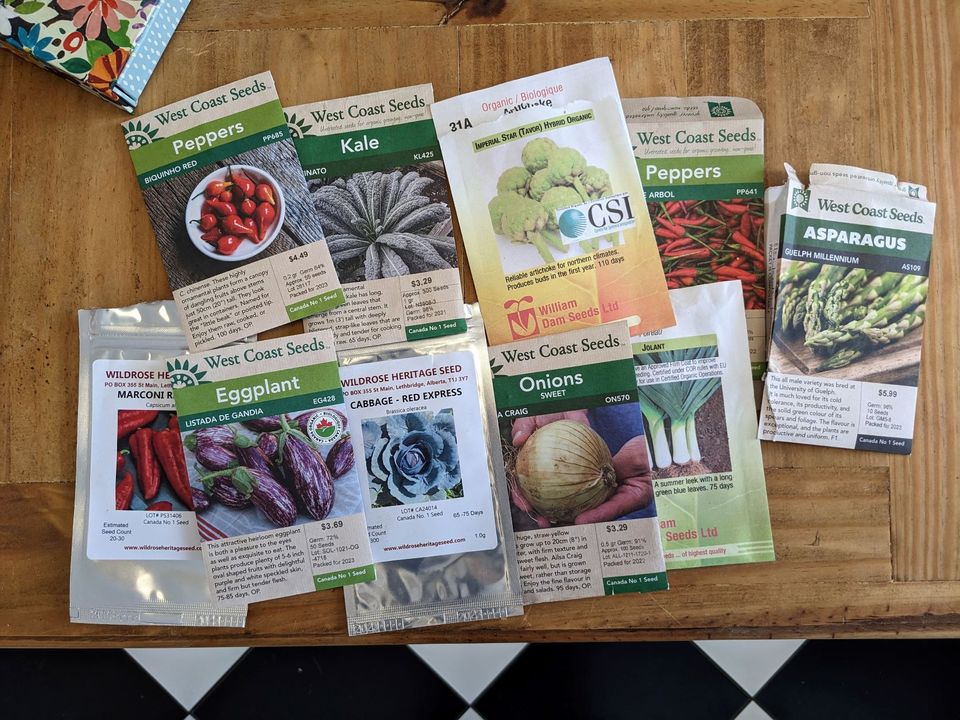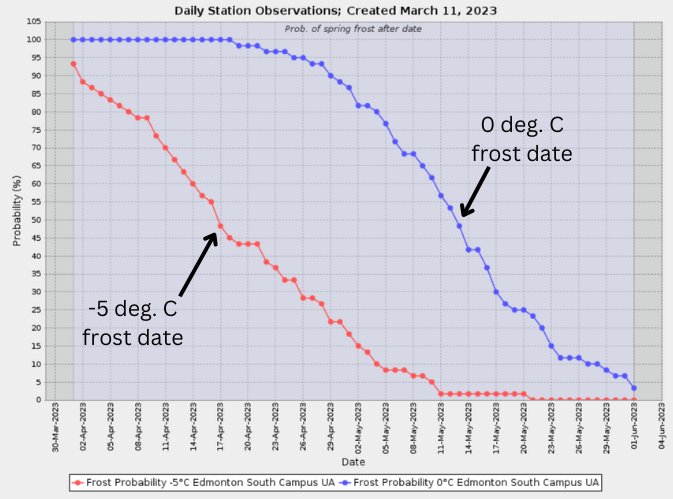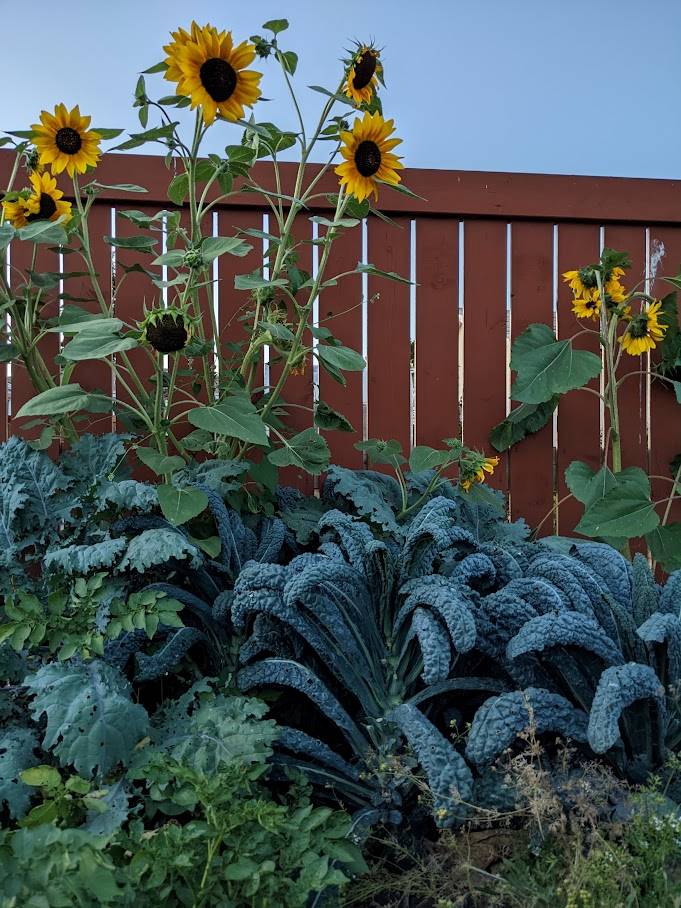What Seeds to Start in March

It's nearly spring time in Alberta, hard to tell as it's -15 deg C (5 deg F) as I'm writing this, but I have officially started some seeds indoors for my zone 3/4 garden.
In this post, I'll let you know what seeds I've been starting and how I decide when to do that.
How do you know when to start seeds indoors?
If you want an easy guide to follow, I recommend checking out these planting guides from Westcoast Seeds for different regions in Canada and the Northern US. They're nice because they give you date ranges for seeding, indoors and outdoors, as well as when you can transplant your seedlings outside. Use these guides to keep it simple and after a few seasons you'll learn what works best for you and your garden!
Are you still reading? Do you want to know more? How do you figure out these seeding dates? What happens if you plant your seeds too early or too late? So many questions...
Firstly, how do you know when to plant your seeds? The key date to know is your area's frost date. Where I live, my frost date is usually given as a date around May 10, but the exact day depends on who you ask.
Once you have your frost date, check out the seed packets of the plants you want to grow and they'll typically tell you how many weeks before the frost date you should plant the seeds. Count backwards from the frost date the number of weeks listed on the seed pack and you'll have your seeding date. Simple!
What does the frost date mean?
This is the day where, in the average year, you wouldn't expect any more frosts to occur. You can find a general date by googling "Your area frost date" but if you want to get really specific (I do) I recommend looking up your province or state's climate information service. Alberta's is called ACIS.
From there you'll have access to weather station data about when frosts have occurred at that exact station. Pick the weather station nearest you and you can see the probability of getting a frost at any given time of the year as a graph or chart. Your specific frost date will be the day when the probability of getting a frost is at 50%, meaning there's a 1 in 2 chance of getting a frost on that day.
ACIS also allows you to look at different degrees of frost, from a 0 degree C frost to a -5 degree C frost. Knowing the frost date for a harder, colder -5 degree frost is useful for knowing when those more cold tolerant plants (your kales, arugulas, asian greens, broccolis and similar) can safely go out or be seeded outside. For my climate, there's nearly one month difference between the two dates, which is a lot of potential growing time for those hardy spring crops!

Notice from the graph that I still have a chance of frost all the way until June, so you won't necessarily be planting things outdoors at the frost date if the weather isn't cooperating. That or you'll be running around outside before you go to bed one night to try and protect everything you just put in the ground.
What if you start your seeds too early?
The time range given on the back of seed packets is based on how long it takes your seeds to germinate and how quickly they grow.
If you start seeds too early, you risk your transplants getting root bound in their pot. This is where the roots run out of growing space and since they have nowhere to go, begin to circle around the pot getting matted and tangled. This can create issues in the future as your plants' roots growth might be limited and can lead to root rot and stunted seedlings. You can avoid this by transferring your seedlings from their small pots to bigger ones as they grow (known as potting on), but there's always a risk that you damage the roots in the process and it's extra work that you may not have time for.
Another issue with starting too early is that your seedlings might get too big to manage in your growing space. Indeterminate tomatoes, for example, with enough light and fertilization can get very big, very quickly even in pots. And if your plants don't have enough light or fertility, then you can run into issues with leggy, sickly looking seedlings that won't thrive when they are planted outside.
What if you start your seeds too late?
One of the challenges of vegetable gardening in a climate like mine, with a short, unpredictable growing season is giving your plants enough time to grow to actually get a harvest.
If you start your seeds too late, then you miss out on that extra window of indoor time and that means you'll be picking vegetables later in the year, or not at all if things don't go your way weather wise.
What seeds am I starting this March?
Ok, so finally, here's what I am actually planting this month.
Early March:
- Onions and shallots - from seed, not from sets. These are slow growing plants and you can trim the green parts if they start getting too long before you have a chance to transplant them outside.
- Leeks - similar to onions, they are slow growing, so it's good to start early.
- Eggplants - these plants like a lot of heat, which we don't always get where I live, so it's important to give them lots of growing time to improve your chances for a harvest. Last year I only got fruit from one of three plants and not until late August, so I'm starting a few weeks earlier and hoping to improve my yield this summer.
- Peppers - like eggplants, they prefer lots of heat as well, so I start them well in advance of my frost date to make sure I get a harvest.
- Kale - Last year I sowed my kale at the beginning of April, but I'm starting some Lacinato (AKA Dinosaur) kale in March to see if I can get some 4 to 5 foot plants by the end of the summer. When I lived in Vancouver I would always see these beautiful, tall kale plants that looked like mini palm trees with the lower stems fully picked, so with the extra growing time I'm aiming for a few of those as interesting garden features.
- Cabbage - This is my first time growing cabbage, so I'm following the advice given by Wildrose Heritage Seeds to start my seedlings early to get a quick harvest of Red Express cabbage before summer hits.
- Asparagus - I'm trying to grow some asparagus from seed and they can take up to 8 weeks to germinate, so I've planted them at the start of the month to give the seedlings some time to grow before they go outside.

Mid to late March:
- Tomatoes - I don't like to start my tomatoes too early, as I've had issues with them getting too tall under the grow lights, especially if our weather ends up being a bit colder than average and there's a delay in planting them.
- Cauliflower and ground cherry - My first attempt at growing these so just following the advice of others here!
- Herbs - I will start basil, mint, thyme and bergamot closer to the end of March.
I hope this helps anyone reading get a good idea of what seeds can be started at this time of year. Getting your timing right involves balancing a lot of different factors and you will get a feel for when things should be seeded as you practice doing it.
It's still early for a zone 3/4 garden, so don't stress if you haven't got any seeds started yet. Also, keep in mind you can always grow a great garden even if you aren't starting any seeds indoors at all! Direct sowing your garden is totally doable if you pick what you want to grow carefully and time when you put your seeds in the ground.
If you've enjoyed this article or found it helpful consider subscribing for more just like it delivered directly to your inbox. Get in touch here if you have any questions or comments.


